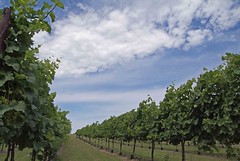
Looking forward to 2005
A Sweet Deal: Central Texas vineyard making its mark
By CLAY COPPEDGE, Country World staff writer
March 27, 2008 – Not far from where legendary viticulturist Thomas Volney Munson discovered one of the grape varieties credited with saving the wine industry in 19th Century France, June Ritterbusch and her husband Sheldon Vickers have started their own vineyard in Bell County.
After planting over three-quarters of an acre in 2005, the couple harvested 1,000 pounds of Chardonnay, Cabernet, Merlot and Sangiovese grapes that first year. Last year, even with excessive rainfall, fungus problems, high humidity and a late-season snowfall, the Salado Vineyard produced about two tons of grapes.
“We had to deal with a drought two years ago and we had too much rain last year,” Ritterbusch said last week as she went about the annual task of pruning. “We’ll just have to wait and see what happens this year.”
The couple sells their grapes to Texas wineries, including Brushy Creek and Red Caboose in Meridian. They have a store in Salado, Texas Wine Seller, that features Texas wines, wine accessories and books that detail Munson’s three-decade odyssey in Texas and elsewhere to find varieties resistant to a devastating parasite that almost wiped out the French wine industry.
Today the prime threat to U.S. grapes is Pierce disease, which is caused by the bacterium xyella fastidiosa and is carried by a leafhopper insect known as the glassy winged sharpshooter. Pierce disease is a primary threat to wine-grape production in Texas and other wine-grape producing states. Wine industry experts say that millions of dollars are lost each year to the disease.
“We haven’t seen it here yet,” she said. “I talked to growers in the Hill Country and they said they hadn’t had a problem with it. Sometimes I wonder if I should have planted some of the resistant varieties.”
Aside from the fungus problems last year, the biggest problems at the Salado Vineyard come from mockingbirds and raccoons. The animals can tell right away when the grapes change color. Speakers designed to annoy the birds out of the vineyard help, but mockingbirds, she said, are fearless.
“The mockingbirds eventually get brave and go on in,” she said. “Some of the other birds see the mockingbirds in the grapes and they decide they can go in there too. It’s a constant battle. We haven’t had problems with deer, maybe because the land right around here is a little too open for them.”
A report from Texas Wine and Grape Growers Association indicate there are about 3,700 acres of family-owned vineyards in the state. MFK LLC, a research source on the wine industry in the United States, reported in 2007 that the number of wineries in Texas increased from 40 in 2000, to 113 in 2005, with most of that growth coming from small wineries.
Ritterbusch said she and her husband hope to eventually expand the operation to include a winery, but they are taking it one step at a time. Despite the daring mockingbirds, sneaky raccoons, the vagaries of weather and the threat of Pierce disease, she enjoys working the vineyard.
“I love it,” she said. “It’s relaxing and rewarding.”
Texas is the fifth largest wine-producing state in the nation, according to the Texas Wine and Grape Growers Association. The 2007 report from MFK LLC estimates that the industry contributes $997.3 million to the state’s economy.
June Ritterbusch, owner and operator of Salado Vineyard, does some trimming to a few of the vines on the property. Ritterbusch and her husband, Sheldon Vickers, started the vineyard in 2005. The first year of harest, the vines produced 1,000 pounds of Chardonnay, Cabernet, Merlot, and Sangiovese grapes. The grapes are sold to Texas wineries.
–Staff photo by Coppedge







